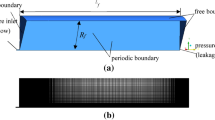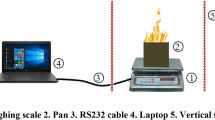Abstract
Water mist is considered as a potential alternative to halon in fire extinguishing applications. However, penetration is remarkably reduced due to the rapid decay of momentum in the process of water mist movement, which makes it difficult for water mist to reach the flame zone to extinguish the fire. To effectively improve the momentum of the water mist, a novel water mist system namely co-flow jet water mist system was proposed. A configuration in which a co-flow jet was induced to control the motion of water mist. A three-dimensional simulation was performed on the gas–liquid flow in this system. The Realizable k-ε model coupled with the discrete phase model (DPM) was employed for high-speed co-flow jet and laden droplets respectively. Simulations were focused on the interaction of the gas–liquid phase. It was found that the potential core length of the co-flow jet was increased owing to the injection of droplets, but the turbulence intensity and the attenuation of the axial velocity of the co-flow jet were reduced by the broken droplets. In addition, the droplets produced by the atomizer were broken into uniform small ones under the action of co-flow jet, and the spatial distribution of droplets was also changed, more importantly, the momentum of droplets was increased effectively. The droplet size as well as spatial distribution and momentum was related to the gas–liquid mass ratio (GLR). The GLR should be increased as much as possible to enhance the performance of the co-flow jet once the required concentration to extinguish a fire is achieved. This technique is helpful to the popularization and application of a water mist system.














Similar content being viewed by others
References
Jones A, Nolan PF (1995) Discussions on the use of fine water sprays or mists for fire suppression. J Loss Prev Process Ind 8(1):17–22
Chelliah HK, Lazzarini AK, Wanigarathne PC, Linteris GT (2002) Inhibition of premixed and non-premixed flames with fine droplets of water and solutions. Proc Combust Inst 29:369–376
Gupta M, Pasi A, Ray A, Kale SR (2013) An experimental study of the effects of water mist characteristics on pool fire suppression. Exp Thermal Fluid Sci 44:768–778
Pancawardani F, Arini D, Yunindar RP, Ramadhan ML, Imran FA, Nugroho YS (2017) Analysis of water mist fire suppression system applied on cellulose fire. Procedia Eng 170:344–351
Zhou Y, Bu R, Zhang X, Fan C, Gong J (2019) Performance evaluation of water mist fire suppression: a clean and sustainable fire-fighting technique in mechanically-ventilated place. J Clean Prod 209:1319–1331
Gupta M, Rajora R, Sahai S, Shankar R, Ray A, Kale SR (2012) Experimental evaluation of fire suppression characteristics of twin fluid water mist system. Fire Saf J 54:130–142
Chelliah HK (2007) Flame inhibition/suppression by water mist: droplet size/surface area, flame structure, and flow residence time effects. Proc Combust Inst 31(2):2711–2719
Vilfayeau S, Myers T, Marshall AW, Trouvé A (2017) Large eddy simulation of suppression of turbulent line fires by base-injected water mist. Proc Combust Inst 36(2):3287–3295
Shrigondekar H, Chowdhury A, Prabhu SV (2018) Characterization of a simplex water mist nozzle and its performance in extinguishing liquid pool fire. Exp Thermal Fluid Sci 93:441–455
Liu Z, Kim AK, Carpenter D (2007) A study of portable water mist fire extinguishers used for extinguishment of multiple fire types. Fire Saf J 42(1):25–42
Ge XX, Zhang XK (2006) Review on water mist fire suppression system. China Pub Secur 5:170–175
Mawhinney JR, Richardson JK (1997) A review of water mist fire suppression research and development. Fire Technol 33(1):54–90
Kim MB, Jang YJ, Kim JK (1996) Burning rate of a pool fire with downward-directed sprays. Fire Saf J 27(1):37–48
Liu JH, Liao GX, Fan WC, Yao B, Lu XY (2002) Study of liquid pool fire suppression with water mists by cone calorimeter. J Fire Sci 20(6):465–477
Cong BH, Liao GX, Huang Z (2009) Extinction limit of diesel pool fires suppressed by water mist. J Fire Sci 27(1):5–26
Liang T, Liu M, Liu Z, Zhong W, Xiao X, Lo S (2015) A study of the probability distribution of pool fire extinguishing times using water mist. Process Saf Environ Prot 93:240–248
Volkov RS, Strizhak PA (2018) Motion of water droplets in the counter flow of high-temperature combustion products. Heat Mass Transf 54(1):193–207
Ferrand V, Bazile R, Borée J, Charnay G (2003) Gas–droplet turbulent velocity correlations and two-phase interaction in an axisymmetric jet laden with partly responsive droplets. Int J Multiph Flow 29:195–217
Jones WP, Lyra S, Marquis AJ (2010) Large Eddy simulation of a droplet laden turbulent mixing layer. Int J Heat Fluid Flow 31(1):93–100
Stakić MB, Živković GS, Sijerčić MA (2011) Numerical analysis of discrete phase induced effects on a gas flow in a turbulent two-phase free jet. Int J Heat Mass Transf 54(11–12):2262–2269
Han Z, Perrish S, Farrell PV, Reitz RD (1997) Modeling atomization processes of pressure-swirl hollow-cone fuel sprays. At Sprays 7(6):663–684
Shih TH, Liou WW, Shabbir A, Yang Z, Zhu J (1995) A new k - ε eddy-viscosity model for high reynolds number turbulent flows - model development and validation. Comput Fluids 24(3):227–238
Schmidt DP, Nouar I, Senecal PK, Rutland CJ, Martin JK, Reitz RD, Hoffman JA (1999) Pressure-swirl atomization in the near field. in Sae International Congress & Exhibition. 1999. Detroit, Michigan
O'Rourke PJ, Amsden AA (1987) The TAB method for numerical calculation of spray droplet breakup. in SAE International Fall Fuels and Lubricants Meeting and Exhibition. Toronto, Ontario
Husted BP, Petersson P, Lund I, Holmstedt G (2009) Comparison of PIV and PDA droplet velocity measurement techniques on two high-pressure water mist nozzles. Fire Saf J 44(8):1030–1045
O’Rourke PJ (1981) Collective drop effects on vaporizing liquid sprays. Princeton University, New Jersey
Liu AB, Mather D, Reitz RD (1993) Modeling the effects of drop drag and breakup on fuel sprays. SAE Technical Paper 930072
Gosman AD, Ioannides E (1983) Aspects of computer simulation of liquid-fuelled combustors. J Energy 7(6):482–490
Longmire P (2007) Computational fluid dynamics (CFD) simulations of aerosol in a U-shaped steam generator tube. Texas A&M University: Texas
Beji T, Zadeh SE, Maragkos G, Merci B (2017) Influence of the particle injection rate, droplet size distribution and volume flux angular distribution on the results and computational time of water spray CFD simulations. Fire Saf J 91:586–595
Mi J, Nobes DS, Nathan GJ (2001) Influence of jet exit conditions on the passive scalar field of an axisymmetric free jet. J Math Fluid Mech 432:91–125
Duffet JC, Benaïssa A (2013) Influence of initial conditions on the evolution towards similarity of passive scalar in turbulent round jets. Exp Thermal Fluid Sci 44:834–843
Arakeri VH, Krothapalli A, Siddavaram V, Alkislar MB, Lourenco L (2003) On the use of microjets to suppress turbulence in a Mach 0.9 axisymmetric jet. J. Fluid Mech 490:75–98
Fleury V, Bailly C, Jondeau E, Michard M, Jové D (2008) Space-time correlations in two subsonic jets using dual-PIV measurements. AIAA J 46(10):2498–2509
Lau JC, Morris PJ, Fisher MJ (1979) Measurements in subsonic and supersonic free jets using a laser velocimeter. J Fluid Mech 93:1–27
Richards CD, Pitts WM (1993) Global density effects on the self-preservation behaviour of turbulent free jets. J Fluid Mech 245:417–435
Mi J, Nobes DS, Nathan GJ (2001) Influence of jet exit conditions on the passive scalar field of an axisymmetric free jet. J. Math. Fluid Mech 432:91–125
Li D, Fan J, Cen K (2012) Direct numerical simulation of the entrainment coefficient and turbulence properties for compressible spatially evolving axisymmetric jets. Fuel 102:470–477
Ball CG, Fellouah H, Pollard A (2012) The flow field in turbulent round free jets. Prog Aerosp Sci 50:1–26
Back GG, Beyler CL, Hansen R (2000) A quasi-steady-state model for predicting fire suppression in spaces protected by water mist systems. Fire Saf J 35(4):327–362
Wu PK, Kirkendall KA, Fuller RP, Nejad AS (1998) Spray structures of liquid jets atomized in subsonic crossflows. J Propul Power 30(20):173–182
Lin KC, Kennedy PJ, Jackson TA (2002) Structures of aerated-liquid jets in high-speed crossflows, in 32nd AIAA Fluid Dynamics Conference and Exihitit. American Institute of Aeronautics and Astronautics. p. 1–12
Author information
Authors and Affiliations
Corresponding author
Additional information
Publisher's Note
Springer Nature remains neutral with regard to jurisdictional claims in published maps and institutional affiliations.
Rights and permissions
About this article
Cite this article
He, M., Zhang, G., Hu, S. et al. Assessment of a Method to Enhance the Momentum of Water Mist: Co-Flow Jet Water Mist System. Fire Technol 58, 435–455 (2022). https://doi.org/10.1007/s10694-021-01128-8
Received:
Accepted:
Published:
Issue Date:
DOI: https://doi.org/10.1007/s10694-021-01128-8




